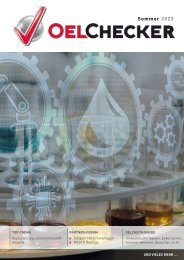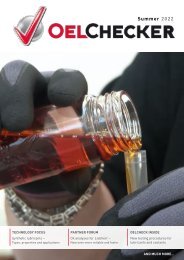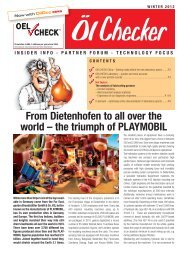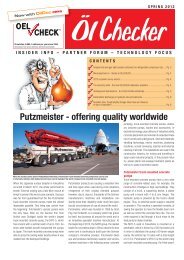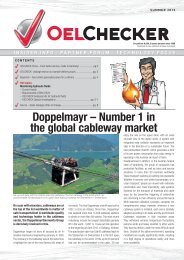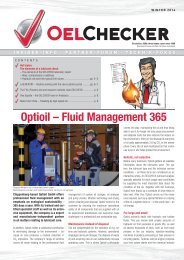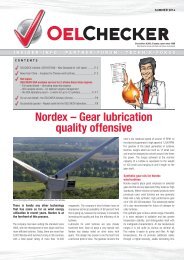OELCHECKER - Spring 2013
> Editorial – OELCHECK takes decisive steps for the years to come > OELCHECK – A strong brand with a new look > New services offered by the OELCHECK laboratory > Lubricants and condition monitoring – OELCHECK recognises trends > Gas engine oils – Latest information on oxidation determination > China – Opening of the OELCHECK laboratory in Guangzhou > Q & A – How can there be high levels of wear metals with normal purity classes? > OilDoc news
> Editorial – OELCHECK takes decisive steps for the years to come
> OELCHECK – A strong brand with a new look
> New services offered by the OELCHECK laboratory
> Lubricants and condition monitoring – OELCHECK recognises trends
> Gas engine oils – Latest information on oxidation determination
> China – Opening of the OELCHECK laboratory in Guangzhou
> Q & A – How can there be high levels of wear metals with normal purity classes?
> OilDoc news
- No tags were found...
Create successful ePaper yourself
Turn your PDF publications into a flip-book with our unique Google optimized e-Paper software.
OELCHECK PARTNER FORUM<br />
Lubricants and Condition Monitoring –<br />
OELCHECK Recognises Future Trends<br />
Lubricant analysis plays a vital role in the monitoring of machinery, or condition monitoring. It provides a wide range of physical<br />
and chemical characteristics that can be used to deduce the condition of both the lubricant and the components of the machine<br />
alike. However, lubricant analysis is set to become even more significant in the future as the demands placed on lubricants<br />
continue to increase. With regard to lubrication and its impact on production and maintenance, OELCHECK diagnostics<br />
engineers are confronted with trends that are bound to become increasingly important in the coming years.<br />
4<br />
Trend 1: Long-Term and Lifetime<br />
Lubrication<br />
Oil is not a renewable resource, and the aim is now<br />
clearly to achieve substantially longer lubricant service<br />
life. Depending on the application concerned,<br />
the often advocated concept of lifetime lubrication<br />
is a potential option. But independent of this, the<br />
trend with regard to long-term use is primarily moving<br />
towards higher-quality base oils (group II or III).<br />
Formulated with highly effective oxidation inhibitors,<br />
these allow you to achieve even longer service<br />
life. Even today, use intervals of 10 years can be<br />
achieved with high-performance industrial gear oils.<br />
In the automotive sector, the aim is to eliminate the<br />
periodic changing of automatic transmission fluids.<br />
Trend 2: Designed to Application<br />
Simplification of the types of lubricants used must<br />
be on the wish list of almost every maintenance<br />
technician. However, the OELCHECK diagnostics<br />
engineers are often confronted with a countertrend.<br />
It is called „designed to application“ and<br />
means that lubricants are tailored to specific applications.<br />
This is the case, for example, for roughly<br />
85% of all automotive lubricants. Around 20 years<br />
ago, the proportion was only 25%.<br />
Another example is industrial gear oils for modern<br />
high-tech gears. In the past, two types of base<br />
oil and four types of active ingredient were available<br />
for the formulation of lubricants. Nowadays,<br />
due to ever-increasing technical demands there<br />
are four different base oils and up to 23 additive<br />
combinations. These tailored products represent a<br />
major challenge for lubricant producers. They also<br />
increase the need for us as analysts, as the wide<br />
range of possible combinations and substances<br />
makes it increasingly difficult to assess the exact<br />
service times of used oils.<br />
Trend 3: Higher Energy Efficiency<br />
Lubricants have an immediate effect not only<br />
on engines and machine components, including<br />
their wear and service life, but also on energy<br />
efficiency. Low-viscosity, low-friction motor oils<br />
have been reducing fuel consumption for many<br />
years. Motor<br />
oil developers will<br />
exploit this potential to a<br />
substantially higher degree<br />
in the future. More and more, the<br />
behaviour of industrial lubricants is being<br />
critically analysed with regard to the efficiency<br />
and performance of the machines.<br />
For many suppliers of modern oils and greases,<br />
energy conservation is a key selling point because<br />
hydraulic fluids or gear oils formulated with specific<br />
additives can save thousands of euros in energy<br />
costs.<br />
Trend 4: Increasing Demands on<br />
Environmental Impact<br />
This primarily relates to hydraulic fluids for mobile<br />
hydraulic systems. However, it also affects total loss<br />
lubricants such as lubricating greases, adhesive<br />
oils or two-stroke mixtures. They must also meet a<br />
multitude of requirements. Biohydraulic fluids need<br />
to remain in use for as long as possible in order to<br />
drive down oil and maintenance costs. At the same<br />
time, they are expected to provide an optimum level<br />
of operational reliability. However, specific environmental<br />
requirements need to be taken into account<br />
when formulating biolubricants. And when it comes<br />
to using plant oils as more readily biodegradable<br />
base oils, understanding how extreme pressure<br />
(EP) additives work is a science in itself.<br />
Trend 5: Lubricants that are Essential to<br />
Facilitate Technical Applications<br />
Alternative construction materials, engines with<br />
catalytic converters or diesel particulate filters, and<br />
modern machining methods are just a few of the<br />
many technological developments that are only<br />
possible with specifically formulated lubricants or<br />
cutting fluids.<br />
For instance, ceramics respond to additives in a<br />
completely different way than metals. Conventional<br />
oils and greases are only suitable to a certain<br />
extent for the lubrication of ceramic components<br />
used in piston rings, roller bearings, compressors,<br />
high-temperature gas turbines or other equipment.<br />
Modern materials can be produced more precisely<br />
and can therefore be more resistant to temperature<br />
and wear than metals. However, their precise surfaces<br />
with low roughness require lubricants that are<br />
„thinner“ and therefore more energy efficient.<br />
In machine tools, metals are predominantly<br />
machined using emulsions of water-miscible cooling<br />
lubricants. A trend towards dry machining is<br />
becoming increasingly clear here. This involves<br />
replacing the emulsion by a very small quantity of<br />
a fully synthetic high-additive oil that is dispensed<br />
directly and precisely through the tool to the cutting<br />
surface. In the case of engines, catalytic converters<br />
and particulate filters make it possible to comply<br />
with evermore stringent emissions standards. However,<br />
for best results and trouble-free operation<br />
these components require low-SAPS motor oils.<br />
These oils contain a lower proportion of sulphur<br />
and phosphorous additives, which are considered<br />
catalyst poisons, and therefore generate fewer<br />
deposits. Low-viscosity motor oils that have been<br />
developed with energy efficiency and environmental<br />
impact in mind are set to play an increasingly<br />
significant role in the future as formulas must<br />
be adapted to comply with the further tightening of<br />
emissions standards.<br />
Trend 6: More Effective Monitoring and<br />
Maintenance of Lubricants<br />
An essential factor for longer operating life is even<br />
more careful maintenance and monitoring of lubricants.<br />
Contamination of oils and greases by wear<br />
particles and other contaminants also increases<br />
over time. Monitoring and maintenance measures<br />
are mandatory because the machines and equipment,<br />
and in turn production reliability, are ultimately<br />
dependent on these measures. Accordingly,<br />
increasingly fine full-flow and partial-flow filters are<br />
being used, and analysis both onsite and in the lab<br />
is becoming indispensable.




